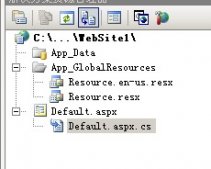前言
本文是我对ASP.NET页面载入速度提高的一些做法,这些做法分为以下部分:
1.采用 HTTP Module 控制页面的生命周期。
2.自定义Response.Filter得到输出流stream生成动态页面的静态内容(磁盘缓存)。
3.页面GZIP压缩。
4.OutputCache 编程方式输出页面缓存。
5.删除页面空白字符串。(类似Google)
6.完全删除ViewState。
7.删除服务器控件生成的垃圾NamingContainer。
8.使用计划任务按时生成页面。(本文不包含该做法的实现)
9.JS,CSS压缩、合并、缓存,图片缓存。(限于文章篇幅,本文不包含该做法的实现)
10.缓存破坏。(不包含第9做法的实现)
针对上述做法,我们首先需要一个 HTTP 模块,它是整个页面流程的入口和核心。
一、自定义Response.Filter得到输出流stream生成动态页面的静态内容(磁盘缓存)
如下的代码我们可以看出,我们以 request.RawUrl 为缓存基础,因为它可以包含任意的QueryString变量,然后我们用MD5加密RawUrl 得到服务器本地文件名的变量,再实例化一个FileInfo操作该文件,如果文件最后一次生成时间小于7天,我们就使用.Net2.0新增的TransmitFile方法将存储文件的静态内容发送到浏览器。如果文件不存在,我们就操作 response.Filter 得到的 Stream 传递给 CommonFilter 类,并利用FileStream写入动态页面的内容到静态文件中。
复制代码代码如下:
namespace ASPNET_CL.Code.HttpModules {
public class CommonModule : IHttpModule {
public void Init( HttpApplication application ) {
application.BeginRequest += Application_BeginRequest;
}
private void Application_BeginRequest( object sender, EventArgs e ) {
var context = HttpContext.Current;
var request = context.Request;
var url = request.RawUrl;
var response = context.Response;
var path = GetPath( url );
var file = new FileInfo( path );
if ( DateTime.Now.Subtract( file.LastWriteTime ).TotalDays < 7 ) {
response.TransmitFile( path );
response.End();
return;
}
try {
var stream = file.OpenWrite();
response.Filter = new CommonFilter( response.Filter, stream );
}
catch ( Exception ) {
//Log.Insert("");
}
}
public void Dispose() {
}
private static string GetPath( string url ) {
var hash = Hash( url );
string fold = HttpContext.Current.Server.MapPath( "~/Temp/" );
return string.Concat( fold, hash );
}
private static string Hash( string url ) {
url = url.ToUpperInvariant();
var md5 = new System.Security.Cryptography.MD5CryptoServiceProvider();
var bs = md5.ComputeHash( Encoding.ASCII.GetBytes( url ) );
var s = new StringBuilder();
foreach ( var b in bs ) {
s.Append( b.ToString( "x2" ).ToLower() );
}
return s.ToString();
}
}
}
二、页面GZIP压缩
对页面GZIP压缩几乎是每篇讲解高性能WEB程序的几大做法之一,因为使用GZIP压缩可以降低服务器发送的字节数,能让客户感觉到网页的速度更快也减少了对带宽的使用情况。当然,这里也存在客户端的浏览器是否支持它。因此,我们要做的是,如果客户端支持GZIP,我们就发送GZIP压缩过的内容,如果不支持,我们直接发送静态文件的内容。幸运的是,现代浏览器IE6.7.8.0,火狐等都支持GZIP。
为了实现这个功能,我们需要改写上面的 Application_BeginRequest 事件:
复制代码代码如下:
private void Application_BeginRequest( object sender, EventArgs e ) {
var context = HttpContext.Current;
var request = context.Request;
var url = request.RawUrl;
var response = context.Response;
var path = GetPath( url );
var file = new FileInfo( path );
// 使用页面压缩
ResponseCompressionType compressionType = this.GetCompressionMode( request );
if ( compressionType != ResponseCompressionType.None ) {
response.AppendHeader( "Content-Encoding", compressionType.ToString().ToLower() );
if ( compressionType == ResponseCompressionType.GZip ) {
response.Filter = new GZipStream( response.Filter, CompressionMode.Compress );
}
else {
response.Filter = new DeflateStream( response.Filter, CompressionMode.Compress );
}
}
if ( DateTime.Now.Subtract( file.LastWriteTime ).TotalMinutes < 5 ) {
response.TransmitFile( path );
response.End();
return;
}
try {
var stream = file.OpenWrite();
response.Filter = new CommonFilter( response.Filter, stream );
}
catch ( Exception ) {
//Log.Insert("");
}
}
private ResponseCompressionType GetCompressionMode( HttpRequest request ) {
string acceptEncoding = request.Headers[ "Accept-Encoding" ];
if ( string.IsNullOrEmpty( acceptEncoding ) )
return ResponseCompressionType.None;
acceptEncoding = acceptEncoding.ToUpperInvariant();
if ( acceptEncoding.Contains( "GZIP" ) )
return ResponseCompressionType.GZip;
else if ( acceptEncoding.Contains( "DEFLATE" ) )
return ResponseCompressionType.Deflate;
else
return ResponseCompressionType.None;
}
private enum ResponseCompressionType {
None,
GZip,
Deflate
}
三、OutputCache 编程方式输出页面缓存
ASP.NET内置的 OutputCache 缓存可以将内容缓存在三个地方:Web服务器、代理服务器和浏览器。当用户访问一个被设置为 OutputCache的页面时,ASP.NET在MSIL之后,先将结果写入output cache缓存,然后在发送到浏览器,当用户访问同一路径的页面时,ASP.NET将直接发送被Cache的内容,而不经过.aspx编译以及执行MSIL的过程,所以,虽然程序的本身效率没有提升,但是页面载入速度却得到了提升。
为了实现这个功能,我们继续改写上面的 Application_BeginRequest 事件,我们在 TransmitFile 后,将这个路径的页面以OutputCache编程的方式缓存起来:
复制代码代码如下:
private void Application_BeginRequest( object sender, EventArgs e ) {
//.............
if ( DateTime.Now.Subtract( file.LastWriteTime ).TotalMinutes < 5 ) {
response.TransmitFile( path );
// 添加 OutputCache 缓存头,并缓存在客户端
response.Cache.SetExpires( DateTime.Now.AddMinutes( 5 ) );
response.Cache.SetCacheability( HttpCacheability.Public );
response.End();
return;
}
//............
}
四、实现CommonFilter类过滤ViewState、过滤NamingContainer、空白字符串,以及生成磁盘的缓存文件
我们传入response.Filter的Stream对象给CommonFilter类:
首先,我们用先Stream的Write方法实现生成磁盘的缓存文件,代码如下,在这些代码中,只有初始化构造函数,Write方法,Close方式是有用的,其中FileStream字段是生成静态文件的操作对象:
复制代码代码如下:
namespace ASPNET_CL.Code.HttpModules {
public class CommonFilter : Stream {
private readonly Stream _responseStream;
private readonly FileStream _cacheStream;
public override bool CanRead {
get {
return false;
}
}
public override bool CanSeek {
get {
return false;
}
}
public override bool CanWrite {
get {
return _responseStream.CanWrite;
}
}
public override long Length {
get {
throw new NotSupportedException();
}
}
public override long Position {
get {
throw new NotSupportedException();
}
set {
throw new NotSupportedException();
}
}
public CommonFilter( Stream responseStream, FileStream stream ) {
_responseStream = responseStream;
_cacheStream = stream;
}
public override long Seek( long offset, SeekOrigin origin ) {
throw new NotSupportedException();
}
public override void SetLength( long length ) {
throw new NotSupportedException();
}
public override int Read( byte[] buffer, int offset, int count ) {
throw new NotSupportedException();
}
public override void Flush() {
_responseStream.Flush();
_cacheStream.Flush();
}
public override void Write( byte[] buffer, int offset, int count ) {
_cacheStream.Write( buffer, offset, count );
_responseStream.Write( buffer, offset, count );
}
public override void Close() {
_responseStream.Close();
_cacheStream.Close();
}
protected override void Dispose( bool disposing ) {
if ( disposing ) {
_responseStream.Dispose();
_cacheStream.Dispose();
}
}
}
}
然后我们利用正则完全删除ViewState:
复制代码代码如下:
// 过滤ViewState
private string ViewStateFilter( string strHTML ) {
string matchString1 = "type=\"hidden\" name=\"__VIEWSTATE\" id=\"__VIEWSTATE\"";
string matchString2 = "type=\"hidden\" name=\"__EVENTVALIDATION\" id=\"__EVENTVALIDATION\"";
string matchString3 = "type=\"hidden\" name=\"__EVENTTARGET\" id=\"__EVENTTARGET\"";
string matchString4 = "type=\"hidden\" name=\"__EVENTARGUMENT\" id=\"__EVENTARGUMENT\"";
string positiveLookahead1 = "(?=.*(" + Regex.Escape( matchString1 ) + "))";
string positiveLookahead2 = "(?=.*(" + Regex.Escape( matchString2 ) + "))";
string positiveLookahead3 = "(?=.*(" + Regex.Escape( matchString3 ) + "))";
string positiveLookahead4 = "(?=.*(" + Regex.Escape( matchString4 ) + "))";
RegexOptions opt = RegexOptions.IgnoreCase | RegexOptions.Singleline | RegexOptions.CultureInvariant | RegexOptions.Compiled;
Regex[] arrRe = new Regex[] {
new Regex("\\s*<div>" + positiveLookahead1 + "(.*?)</div>\\s*", opt),
new Regex("\\s*<div>" + positiveLookahead2 + "(.*?)</div>\\s*", opt),
new Regex("\\s*<div>" + positiveLookahead3 + "(.*?)</div>\\s*", opt),
new Regex("\\s*<div>" + positiveLookahead3 + "(.*?)</div>\\s*", opt),
new Regex("\\s*<div>" + positiveLookahead4 + "(.*?)</div>\\s*", opt)
};
foreach ( Regex re in arrRe ) {
strHTML = re.Replace( strHTML, "" );
}
return strHTML;
}
以下是删除页面空白的方法:
复制代码代码如下:
// 删除空白
private Regex tabsRe = new Regex( "\\t", RegexOptions.Compiled | RegexOptions.Multiline );
private Regex carriageReturnRe = new Regex( ">\\r\\n<", RegexOptions.Compiled | RegexOptions.Multiline );
private Regex carriageReturnSafeRe = new Regex( "\\r\\n", RegexOptions.Compiled | RegexOptions.Multiline );
private Regex multipleSpaces = new Regex( " ", RegexOptions.Compiled | RegexOptions.Multiline );
private Regex spaceBetweenTags = new Regex( ">\\s<", RegexOptions.Compiled | RegexOptions.Multiline );
private string WhitespaceFilter( string html ) {
html = tabsRe.Replace( html, string.Empty );
html = carriageReturnRe.Replace( html, "><" );
html = carriageReturnSafeRe.Replace( html, " " );
while ( multipleSpaces.IsMatch( html ) )
html = multipleSpaces.Replace( html, " " );
html = spaceBetweenTags.Replace( html, "><" );
html = html.Replace( "//<![CDATA[", "" );
html = html.Replace( "//]]>", "" );
return html;
}
以下是删除ASP.NET控件的垃圾UniqueID名称方法:
复制代码代码如下:
// 过滤NamingContainer
private string NamingContainerFilter( string html ) {
RegexOptions opt =
RegexOptions.IgnoreCase |
RegexOptions.Singleline |
RegexOptions.CultureInvariant |
RegexOptions.Compiled;
Regex re = new Regex( "( name=\")(?=.*(" + Regex.Escape( "$" ) + "))([^\"]+?)(\")", opt );
html = re.Replace( html, new MatchEvaluator( delegate( Match m ) {
int lastDollarSignIndex = m.Value.LastIndexOf( '$' );
if ( lastDollarSignIndex >= 0 ) {
return m.Groups[ 1 ].Value + m.Value.Substring( lastDollarSignIndex + 1 );
}
else {
return m.Value;
}
} ) );
return html;
}
最后,我们把以上过滤方法整合到CommonFilter类的Write方法:
复制代码代码如下:
public override void Write( byte[] buffer, int offset, int count ) {
// 转换buffer为字符串
byte[] data = new byte[ count ];
Buffer.BlockCopy( buffer, offset, data, 0, count );
string html = System.Text.Encoding.UTF8.GetString( buffer );
//
// 以下整合过滤方法
//
html = NamingContainerFilter( html );
html = ViewStateFilter( html );
html = WhitespaceFilter( html );
byte[] outdata = System.Text.Encoding.UTF8.GetBytes( html );
// 写入磁盘
_cacheStream.Write( outdata, 0, outdata.GetLength( 0 ) );
_responseStream.Write( outdata, 0, outdata.GetLength( 0 ) );
}
五、缓存破坏
经过以上程序的实现,网页已经被高速缓存在客户端了,如果果用户访问网站被缓存过的页面,则页面会以0请求的速度加载页面。但是,如果后台更新了某些数据,前台用户则不能及时看到最新的数据,因此要改变这种情况,我们必须破坏缓存。根据我们如上的程序,我们破坏缓存只需要做2步:更新服务器上的临时文件,删除OutputCache过的页面。
更新服务器上的文件我们只需删除这个文件即可,当某一用户第一次访问该页面时会自动生成,当然,你也可以用程序先删除后生成:
复制代码代码如下:
// 更新文件
foreach ( var file in Directory.GetFiles( HttpRuntime.AppDomainAppPath + "Temp" ) ) {
File.Delete( file );
}
要删除OutputCache关联的缓存项,代码如下,我们只需要保证该方法的参数,指页面的绝对路径是正确的,路径不能使用../这样的相对路径:
复制代码代码如下:
// 删除缓存
HttpResponse.RemoveOutputCacheItem( "/Default.aspx" );
到此,我们实现了针对一个页面的性能,重点是载入速度的提高的一些做法,希望对大家有用~!












